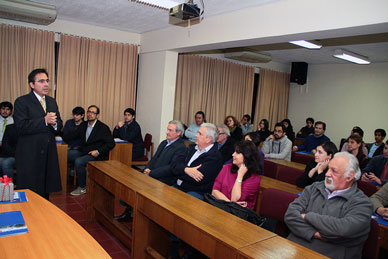- The benefit of using geophysical techniques to recover historical remains was one of the main conclusions of the “Taller de Geofísica aplicada al Patrimonio Críptico Heredado.” “By using mining technologies, we want to bring our country’s historical riches out of the depths of the Earth, without impacting the environment,” Dr Lucio Cañete, one of the organizers, said.
On July 02nd, the closing ceremony of the third “Taller de Geofísica aplicada al Patrimonio Críptico Heredado” was held at the Conference Room of the Technological Faculty. The workshop was led by the Dean of that Faculty, Gumercindo Vilca Cáceres and was attended by several university authorities.
The workshop gathered together almost one hundred men and women of different ages and from different professional areas.
The workshop was given in the context of the outreach activities developed by the Technological Faculty. This is the reason why “We emphasized that the participants should not be part of the university community: to have an impact at a society level,” Dr Lucio Cañete explained.
The workshop
According to Dr Cañete, the purpose of the workshop was to give basic knowledge of geophysics and its potential applications to a general audience interested in the inherited cryptical material, “that is to say, a paleontological or archaeological resource that it is not visible, that remains under ground, covered by vegetation or ice.”
“We referred to gravimetry, seismology, magnetometry and electrical resistivity, which are used to prospect for mining resources. Chile is very rich in these resources,” the researcher said, regarding the techniques addressed during the workshop.
However, the team of experts led by Dr Lucio Cañete learned that these techniques could mean a significant contribution to a different type of excavation: the digs for the past.
“Chile has hidden riches that we want to reveal through these techniques: the riches of our past,” Dr Cañete said.
According to him, our territory is rich in archaeological elements; for this reason, we need the tools to unearth the past without altering the ecosystem.
“Historical research has shown that the first settlements in our territory started 13 thousand years ago. The first remains of human settlements in the American continent were confirmed in Chile,” he said.
“We have a whole rich past that must be revealed, but this must be done with techniques that will not impact the heritage while we are trying to bring it out,” Dr Cañete stressed.
Digging is a very intrusive method; therefore, if it is used, “The destruction of the evidence of the past is highly probable. However, geophysical techniques use disturbances that allow “seeing without touching,” he added.
Geophysical techniques
Gravimetry measures the variation of the strength of a gravitational field; magnetometry measures how a magnetic field changes; seismology, by means of man-caused little microseisms, allows to see what is under the surface, and, finally, the electrical resistivity measures the changes in ground resistance when introducing an electric current into the subsurface.
Regardless of the surface, the use of these techniques “Produce a sort of disturbance that does not affect the part of the patrimony that we want to know,” Dr Cañete said.
In this regard, the main goal of the workshop was to understand these techniques and see how their use in the mining industry can be a real contribution to surveying archaeological, historical and paleontological remains.
“We saw this and, and in our role as a public and state university, we called for the development of all these techniques that, although they are traditional in mining industry, could be used in a new scientific field: the field of the sciences that study the past,” he added
“By using these mining technologies, we want to bring our country’s historical riches out of the depths of the Earth, without impacting the environment,” Dr Cañete concluded.
Translated by Marcela Contreras



